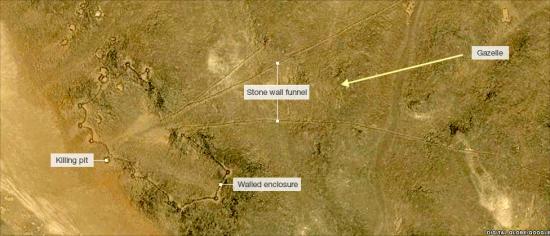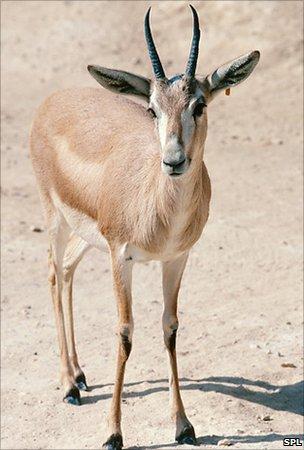Gazelles caught in ancient Syrian 'killing zones'
Jonathan.Amos
Source - http://www.bbc.co.uk/news/science-environment-13123221

'Desert kites' were named for their shape by British airmen. There are large numbers right across the region
It was slaughter on a huge scale.
Hundreds of migrating gazelles would be funnelled into enclosures where they could be butchered en masse.
This was the practice of communities living some 6,000 years ago in what is now north-eastern Syria.
Archaeologists say they have unearthed the remains of animals forced into these killing zones.
They tell the journal PNAS that is was an early example of over-hunting.
So many Persian gazelles (Gazella subgutturosa) would be taken down that it must have had a catastrophic impact on animal populations.
"We counted more than 100 individuals, comprising equal numbers of males and females," explained Dr Guy Bar-Oz from the Zinman Institute of Archaeology at the University of Haifa, Israel.
"This was the killing place where they were slaughtered before they were transferred for consumption or trade," he told BBC News.
It has long been suspected that the enigmatic stone structures that dot the Syrian landscape were involved in harvesting gazelles.
Built perhaps as far back as 10,000 years ago, these structures display converging pairs of low stone walls.
When British air force pilots first flew over them in the early 20th Century, they dubbed them "desert kites" because of their characteristic appearance from the air.
A number of researchers have assumed that passing herds of migrating gazelles and other animals would be channelled between the walls and into large enclosures at the apex.
But definitive evidence of mass slaughter has been scant until recently.

Gazelle populations would have rapidly declined
Drs Bar-Oz, Melinda Zeder and Frank Hole describe in PNAS the discovery of a large deposit of gazelle bones at the site of Tell Kuran, near the town of Hasseke in the Khabur Basin.
This killing pit is very close to a number of desert kites and contains thousands of gazelle parts.
"It is manifest that these remains are from a catastrophic hunting episode - a full herd was killed," said Dr Bar-Oz.
"The demographic of the herd suggests it was early summer, given that there were a few juveniles of two or three months of age.
"We see mainly skull parts and hooves; and some of the toes have those butchery marks that indicate removal of the skin as well as of the muscles."
The inhabitants of Tell Kuran would have been an agricultural community and would almost certainly have kept large groups of livestock.
Why they should have engaged in an overkill practice such as this is an interesting question.
But a compelling explanation may be found in nearby rock art that depicts gazelles being ritualistically slaughtered in stone traps and kites.
These images date to the time of Tell Kuran.
The team suggests the farmers and herders of Tell Kuran performed mass killings as spiritually significant social events.
The impact on gazelle populations would have been disastrous, however.
Whereas the limited activities of ancient hunter-gatherer societies may even have nurtured herds, preventing them from getting too big and damaging the landscape, this systematic removal of whole breeding groups would have rapidly reduced gazelle numbers in the Khabur Basin.
And with kites spread right across the Near East, with large arrays in Jordan in particular, the impact on what was once an abundant wild ungulate must have been profound.
